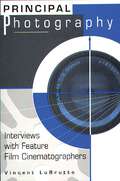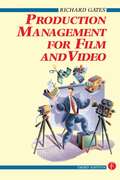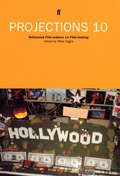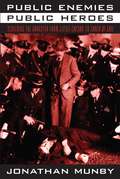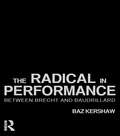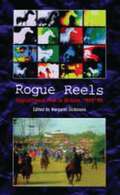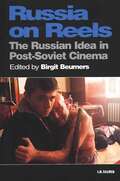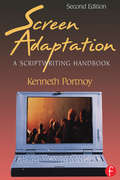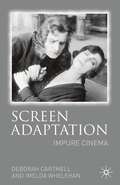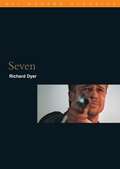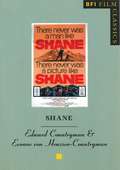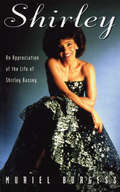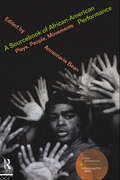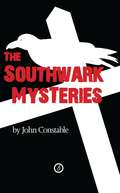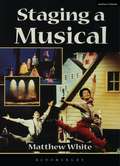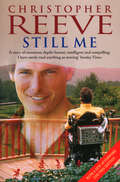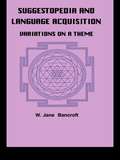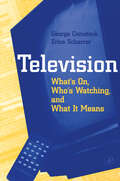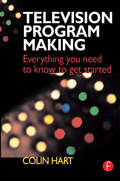- Table View
- List View
Principal Photography: Interviews with Feature Film Cinematographers
by Vincent LoBruttoBy using photography as a storytelling medium, the cinematographer plays a key role in translating a screenplay into images and capturing the director's vision of a film. This volume presents in-depth interviews with 13 prominent cinematographers, who discuss their careers and the art and craft of feature film cinematography. The interviewees—who represent the spectrum of big-budget Hollywood and low-budget independent filmmaking from the sixties through the nineties—talk about their responsibilities, including lighting, camera movement, equipment, cinematic grammar, lenses, film stocks, interpreting the script, the budget and schedule, and the psychological effect of images. Each interview is preceded by a short biography and a selected filmography, which provide the background for a detailed analysis of the photographic style and technique of many highly acclaimed and seminal films.
Production Management for Film and Video
by Richard GatesPacked with step by step information, hints and tips, this book provides all the basic information needed to production manage a film or video from beginning to end - from idea to delivery. Production Management for Film and Video gives all the basic information needed to production manage a film or video from beginning to end - from idea to delivery.Aspiring young film producers, programme makers and students of film or video production will find this an essential source of information, as indeed will anybody wishing to improve their knowledge and skills in the field. One is guided from the script or proposal, right through the various stages of production management to include:· script breakdown· crossplotting· scheduling· budgeting· preparation· the shoot· editing and post-production· deliveryNow in its third edition, Production Management for Film and Video has been further revised to include: · information on health and safety requirements· the need to be aware of computer generated imagery · the effect this kind of programme making has on schedules and budgets. Different kinds of management for different productions are also covered - from features through to documentaries - and advice is offered on how to run a production more effectively. Examples, taken from actual productions, demonstrate the kind of documentation needed to develop, run and control a production. Emphasis is placed on the basic principles of good management that apply to all the different kinds of film that can be produced.Richard Gates is a freelance producer/production manager and has been involved in over 40 productions of different kinds. He also lectures extensively on production and production management techniques.
Production Management for Film and Video
by Richard GatesPacked with step by step information, hints and tips, this book provides all the basic information needed to production manage a film or video from beginning to end - from idea to delivery. Production Management for Film and Video gives all the basic information needed to production manage a film or video from beginning to end - from idea to delivery.Aspiring young film producers, programme makers and students of film or video production will find this an essential source of information, as indeed will anybody wishing to improve their knowledge and skills in the field. One is guided from the script or proposal, right through the various stages of production management to include:· script breakdown· crossplotting· scheduling· budgeting· preparation· the shoot· editing and post-production· deliveryNow in its third edition, Production Management for Film and Video has been further revised to include: · information on health and safety requirements· the need to be aware of computer generated imagery · the effect this kind of programme making has on schedules and budgets. Different kinds of management for different productions are also covered - from features through to documentaries - and advice is offered on how to run a production more effectively. Examples, taken from actual productions, demonstrate the kind of documentation needed to develop, run and control a production. Emphasis is placed on the basic principles of good management that apply to all the different kinds of film that can be produced.Richard Gates is a freelance producer/production manager and has been involved in over 40 productions of different kinds. He also lectures extensively on production and production management techniques.
Projections 10: Hollywood Film-makers On Film-making
by Mike FiggisMike Figgis has always been intrigued by the workings of the Hollywood System. As he progressed from his acclaimed US debut Internal Affairs, through hellish studio wrangles on Mr. Jones, to Oscar-laurelled success with Leaving Las Vegas, Figgis always wanted to find a way to document the mores of the Hollywood industry, before it could swallow him whole. For Projections, he accepted an invitation to return to LA in late 1998 and create just such a document. In conversation with established players such as Mel Gibson, Jodie Foster and Jerry Bruckheimer, plus ascending talents such as Salma Hayek and Paul Thomas Anderson, Figgis paints a refreshingly honest but unmistakably dark portrait of an industry where money does more than talk.Mike Figgis's witnesses include Mel Gibson, Jodie Foster, Mickey Rourke, Nastassja Kinski, Elizabeth Shue, Salma Hayek, Paul Thomas Anderson, Jerry Bruckheimer and many more . . .
Public Enemies, Public Heroes: Screening the Gangster from Little Caesar to Touch of Evil
by Jonathan MunbyIn this study of Hollywood gangster films, Jonathan Munby examines their controversial content and how it was subjected to continual moral and political censure. Beginning in the early 1930s, these films told compelling stories about ethnic urban lower-class desires to "make it" in an America dominated by Anglo-Saxon Protestant ideals and devastated by the Great Depression. By the late 1940s, however, their focus shifted to the problems of a culture maladjusting to a new peacetime sociopolitical order governed by corporate capitalism. The gangster no longer challenged the establishment; the issue was not "making it," but simply "making do." Combining film analysis with archival material from the Production Code Administration (Hollywood's self-censoring authority), Munby shows how the industry circumvented censure, and how its altered gangsters (influenced by European filmmakers) fueled the infamous inquisitions of Hollywood in the postwar '40s and '50s by the House Committee on Un-American Activities. Ultimately, this provocative study suggests that we rethink our ideas about crime and violence in depictions of Americans fighting against the status quo.
The Radical in Performance: Between Brecht and Baudrillard
by Baz KershawThe Radical in Performance investigates the crisis in contemporary theatre, and celebrates the subversive in performance. It is the first full-length study to explore the link between a western theatre which, says Kershaw, is largely outdated and the blossoming of postmodern performance, much of which has a genuinely radical edge. In staying focused on the period between Brecht and Baudrillard, modernity and postmodernism, Baz Kershaw identifies crucial resources for the revitalisation of the radical across a wide spectrum of cultural practices. This is a timely, necessary and rigorous book. It will be a compelling read for anyone searching for a critical catalyst for new ways of viewing and practising cultural politics.
The Radical in Performance: Between Brecht and Baudrillard
by Baz KershawThe Radical in Performance investigates the crisis in contemporary theatre, and celebrates the subversive in performance. It is the first full-length study to explore the link between a western theatre which, says Kershaw, is largely outdated and the blossoming of postmodern performance, much of which has a genuinely radical edge. In staying focused on the period between Brecht and Baudrillard, modernity and postmodernism, Baz Kershaw identifies crucial resources for the revitalisation of the radical across a wide spectrum of cultural practices. This is a timely, necessary and rigorous book. It will be a compelling read for anyone searching for a critical catalyst for new ways of viewing and practising cultural politics.
Rogue Reels: Oppositional Film in Britain, 1945-90
by Margaret DickinsonMargaret Dickinson's history of oppostional film is a pioneering account of an important by little documented aspect of modern British Cinema: the often extreme form of independent cinema that accompanied the radical politics of the 1960s and 70s. During the 70s an organized independent film and video movement emerged (including such filmmaking groups as London Filmmakers' Co-op, Cinema Action, Amber, Liberation Films and Sheffield Co-op). This avant-garde exerted an increasing influence within the British media mainstream - changing attitudes and practice, and enabling cross-over work by filmmakers such as Peter Greenaway and Sally Potter. This oppostional sector revolutionized British media, especially during the formation of Channel Four at the start of the 1980s, even as the political landscape at large was shifting dramatically to the right. Organized into three parts, 'Rogue Reels 'provides the first overview of the various strands of politicized filmmaking that emerged in postwar Britain. Part I is a concise history of the movement. Part II collects key texts and documents form the period 1971-92. Part III is made up of seven oral histories of the most influential production houses. Recuperating the radical tradition of postwar filmmaking (which continues to impact on today's media culture), 'Rogue Reels' raises urgent issues of policy and practice. Mixing narrative with first-hand accounts, and the important statements and documents of this movement the book provides the first overview of the different strands of filmmaking that are still impacting on avant-garde and mainstream practice.
Russia on Reels: The Russian Idea in Post-Soviet Cinema (KINO - The Russian and Soviet Cinema)
by Birgit BeumersThis is the first book to deal exclusively with Russian cinema of the 1990s. It introduces readers to the currents and common interests of contemporary Russian cinema, offers close studies of the work of filmmakers like Sokurov, Muratova and Astrakhan, reviews the Russian film industry in a period of massive economic transformation, and assesses cinema's function as a definer of Russia's new identity.
Screen Adaptation: A Scriptwriting Handbook
by Kenneth PortnoyScreen Adaptation : A Scriptwriting Handbook, 2nd ed. examines the challenge screenwriters face when adapting novels, plays, and short stories for the screen. Thoroughly updated to include new exercises and example from current films, this book provides practical, usable information on how to find the best plot line for a script, choose key characters, and understand the goals and formats of different genres. Topics include: determining which characters and events are most valuable on developing the main story;expanding short novellas and condensing long novels;using dialog to advance the story and reveal character;comparing the formats of plays, short stories, and novels to those of screenplaysapproaching the marketplaceIn this book, both beginning writers and professionals will find the tools necessary to evaluate a prospective source and create a successful screenplay
Screen Adaptation: A Scriptwriting Handbook
by Kenneth PortnoyScreen Adaptation : A Scriptwriting Handbook, 2nd ed. examines the challenge screenwriters face when adapting novels, plays, and short stories for the screen. Thoroughly updated to include new exercises and example from current films, this book provides practical, usable information on how to find the best plot line for a script, choose key characters, and understand the goals and formats of different genres. Topics include: determining which characters and events are most valuable on developing the main story;expanding short novellas and condensing long novels;using dialog to advance the story and reveal character;comparing the formats of plays, short stories, and novels to those of screenplaysapproaching the marketplaceIn this book, both beginning writers and professionals will find the tools necessary to evaluate a prospective source and create a successful screenplay
Screen Adaptation: Impure Cinema
by Hester Bradley Imelda WhelehanAdaptation studies has historically been neglected in both the English and Film Studies curricula. Reflecting on this, Screen Adaptation celebrates its emergence in the late 20th and 21st centuries and explores the varieties of methodologies and debates within the field. Drawing on approaches from genre studies to transtexuality to cultural materialism, the book examines adaptations of both popular and canonical writers, including William Shakespeare, Jane Austen and J.K.Rowling.Original and provocative, this book will spark new thinking and research in the field of adaptation studies. Mapping the way in which this exciting field has emerged and shifted over the last two decades, the book is also essential reading for students of English Literature and Film.
Seven: Smew's Greed (BFI Film Classics)
by Richard DyerGluttony, Greed, Sloth, Lust, Pride, Envy, Wrath. A serial killer on a warped mission who turns his victims' 'sins' into the means of their murder. Seven (David Fincher, 1995) is one of the most acclaimed American films of the 1990s. Starring Morgan Freeman, Brad Pitt, and Kevin Spacey, Seven is the darkest of films. In it performance, cinematography, sound, and plot combine to create a harrowing account of a world beset by an all-encompassing, irremediable wickedness. Richard Dyer explores the film in terms of of sin, story, structure, seriality, sound, sight and salvation, analyzing how Seven both epitomizes and modifies the serial killer genre, which is such a feature of recent cinema.
Shane (BFI Film Classics)
by Edward Countryman Evonne Von Heussen-CountrymanThis text looks at the film 'Shane' (1983) directed by George Stevens, then one of Hollywood's most successful film-makers. Alan Ladd plays the charismatic outsider who defends a community against a predatory gang and, in so doing, transforms the life of a family.
Shirley: An Appreciation Of The Life Of Shirley Bassey
by Muriel BurgessShirley Bassey is one of the all-time greats of the entertainment business. She has sold more records than any other British female singer and still commands massive audiences around the world. Now, after a career spanning decades, her life story can be told: the story of a triumph over enough tragedies to last several lifetimes. The personal hardships that have fuelled the emotionalism of her songs have never before been revealed. Here her poverty-stricken childhood in Wales is detailed: how her mother struggled to bring up seven children on Income Support after their Nigerian father was deported; how she worked in a saucepan factory when her first struggles for stardom were halted by her pregnancy at sixteen. Shirley had a series of tortured loves: she married a homosexual Cockney who died of an overdose; she had a highly publicised affair with actor Peter Finch; and her second marriage, to an Italian, also failed. The shocking death of her second daughter, Samantha, just before her 21st birthday caused Shirley to lose her voice for nearly a year. Behind the showbiz glamour and consummate professionalism lies a fiercely resilient and independent woman.
A Sourcebook on African-American Performance: Plays, People, Movements (Worlds of Performance)
by Annemarie BeanA Sourcebook on African-American Performance is the first volume to consider African-American performance between and beyond the Black Arts Movement of the 1960s and the New Black Renaissance of the 1990s.As with all titles in the Worlds of Performance series, the Sourcebook consists of classic texts as well as newly commissioned pieces by notable scholars, writers and performers. It includes the plays 'Sally's Rape' by Robbie McCauley and 'The American Play' by Suzan-Lori Parks, and comes complete with a substantial, historical introduction by Annemarie Bean.Articles, essays, manifestos and interviews included cover topics such as:* theatre on the professional, revolutionary and college stages* concert dance* community activism * step shows* performance art.Contributors include Annemarie Bean, Ed Bullins, Barbara Lewis, John O'Neal, Glenda Dickersun, James V. Hatch, Warren Budine Jr. and Eugene Nesmith.
A Sourcebook on African-American Performance: Plays, People, Movements (Worlds of Performance)
by Annemarie BeanA Sourcebook on African-American Performance is the first volume to consider African-American performance between and beyond the Black Arts Movement of the 1960s and the New Black Renaissance of the 1990s.As with all titles in the Worlds of Performance series, the Sourcebook consists of classic texts as well as newly commissioned pieces by notable scholars, writers and performers. It includes the plays 'Sally's Rape' by Robbie McCauley and 'The American Play' by Suzan-Lori Parks, and comes complete with a substantial, historical introduction by Annemarie Bean.Articles, essays, manifestos and interviews included cover topics such as:* theatre on the professional, revolutionary and college stages* concert dance* community activism * step shows* performance art.Contributors include Annemarie Bean, Ed Bullins, Barbara Lewis, John O'Neal, Glenda Dickersun, James V. Hatch, Warren Budine Jr. and Eugene Nesmith.
The Southwark Mysteries
by John Constable“I was born a Goose of Southwark by the Grace of Mary Overie, Whose Bishop gives me licence to sin within The Liberty. In Bankside stews and taverns you can hear me honk right daintily, As I unlock the hidden door, unveil the Secret History.” The Liberty of the Clink dates back to 1107 when the Bishop of Winchester was granted a stretch of the Southwark Bankside, which lay outside the law of the City of London. Here, the Bishop controlled the brothels, or stews. The whores of The Liberty were known as Winchester Geese. The Vision Books of The Southwark Mysteries were first revealed by The Goose to John Crow, trickster-familiar of the poet and playwright John Constable, on 23rd November 1996. In these apocalyptic verses, John Crow encounters The Goose at Crossbones, the whores’ graveyard unearthed during work on the Jubilee Line Extension. She initiates him into a secret history spanning 2,000 years – a vision of the Spirit in the flesh, the Sacred in the profane, Eternity in time. This vision informs The Mystery Plays, a contemporary “Southwark Cycle” rooted in the medieval mysteries, retelling sacred stories in the earthy language and context of our own time and place. This epic drama was first performed in Shakespeare’s Globe and Southwark Cathedral on Easter Sunday, 23rd April 2000. A new production was presented in Southwark Cathedral in 2010. The third part of the work is a Glossolalia of local history and esoteric lore to be read in conjunction with the poems and plays." "Past and present, sacred and profane jostle and collide in a glorious tumult in this anarchic drama... it’s couched in verse that is muscular, ribald, and often dazzlingly rich... It’s sprawling and unashamedly ragged in execution, but it’s irrepressibly vital: a joyous, gutsy celebration of life, love, faith and forgiveness. " - Sam Marlowe, The Times
Staging a Musical: An Essential Guide (Backstage)
by Matthew WhiteA step-by-step guide to the whole process of putting on a musical, placing a firm emphasis upon good organisation and careful planning. This book describes all the elements involved including: how to choose the right show, budgets and schedules, auditions, rehearsals and performances. There are also sections on set designs, costumes, sound, lighting and publicity.
Still Me: A Life
by Christopher ReeveThrough his leading role in the three Superman films, Christopher Reeve became so closely identified with the superhero that he wasn't just seen as the actor who played Superman, he was Superman. Which is why the tragic riding accident which left him paralysed from the neck down shocked the world. Superman was not superhuman. It is also why he is now the world's most recognisable person in a wheelchair. In true superhero style, Christopher Reeve refuses to resign himself to the life of a quadriplegic, and is actively campaigning to raise the profile of spinal-cord injury victims and research. Although he was initially told that he would only ever be able to move his head, he can now shrug his shoulders and breathe alone for increasing periods of time, and is determined that he will walk again. It is this extraordinary courage and determination that has made Christopher Reeve the internationally admired figure that he is, and it is this bravery which makes this autobiography about his paralysis and his journey to recovery such a powerful and moving story.
Suggestopedia and Language
by W. Jane BancroftFirst published in 1999. Routledge is an imprint of Taylor & Francis, an informa company.
Suggestopedia and Language
by W. Jane BancroftFirst published in 1999. Routledge is an imprint of Taylor & Francis, an informa company.
Television: What's on, Who's Watching, and What it Means
by George Comstock Erica ScharrerTelevision: What's On, Who's Watching, and What It Means presents a comprehensive examination of the role of television in one's life. The emphasis is on data collected over the past two decades pointing to an increasing and in some instances a surprising influence of the medium. Television is not only watched but its messages are attended to and well understood. There is no shame in spending hours in front of the set, in fact, people over-estimate the time they spend viewing. Television advertising no longer persuades--it sells by creating a burst of emotional liking for the commercial. The emphases of television news determine not only what voters think about but also the presidential candidate they expect to support on election day. Children and teenagers who watch a great deal of television perform poorly on standardized achievement tests, and among the reasons are the usurpation of time spent learning to read and the discouragement of book reading. Television violence frightens some children and excites others, but its foremost effect is to increase aggressive behavior that sometimes spills over into seriously harmful antisocial behavior.Incorporates social psychology, political science, sociology, child development, and the growing field of communicationsPresents tables and graphs clarifying theories and linking sets of dataPaints concise portraits of the role of television in entertainment, politics, and child-rearingContains background for dozens of lectures and articlesContains a comprehensive bibliography of more than 1000 citations, many recent
Television Program Making: Everything you need to know to get started
by Colin HartThis book is for anyone starting out or hoping to work in the ever-expanding world of television and video. Everyone involved in a TV or video production is contributing to the program making process. They all need to know and understand how it happens. Whatever you want to end up doing, whether you are part way through a course or starting from scratch, this book gives you all the essential information you will need. It takes a practical, step-by-step approach, based on the author's own 25-year experience of producing, writing and directing for broadcast television and the corporate sector on both video and film. It describes the roles people perform, the equipment they use and what it does. In simple, easy-to-read language it explains the grammar of shooting and editing and offers first-hand advice on treatments, scripts and budgets. As well as covering the technical aspects of both single and multi-camera production, it also looks at the editorial elements that create a successful program. With practical examples it demonstrates how best to turn ideas into reality, how to obtain successful interviews and how to put together programs that work. Colin Hart has his own production company making programs for corporate clients. He trained as a single and multi-camera director in local televison news and for ten years worked in BBC Current Affairs producing and directing for Nationwide and The Money Programme.
Television Program Making: Everything you need to know to get started
by Colin HartThis book is for anyone starting out or hoping to work in the ever-expanding world of television and video. Everyone involved in a TV or video production is contributing to the program making process. They all need to know and understand how it happens. Whatever you want to end up doing, whether you are part way through a course or starting from scratch, this book gives you all the essential information you will need. It takes a practical, step-by-step approach, based on the author's own 25-year experience of producing, writing and directing for broadcast television and the corporate sector on both video and film. It describes the roles people perform, the equipment they use and what it does. In simple, easy-to-read language it explains the grammar of shooting and editing and offers first-hand advice on treatments, scripts and budgets. As well as covering the technical aspects of both single and multi-camera production, it also looks at the editorial elements that create a successful program. With practical examples it demonstrates how best to turn ideas into reality, how to obtain successful interviews and how to put together programs that work. Colin Hart has his own production company making programs for corporate clients. He trained as a single and multi-camera director in local televison news and for ten years worked in BBC Current Affairs producing and directing for Nationwide and The Money Programme.
